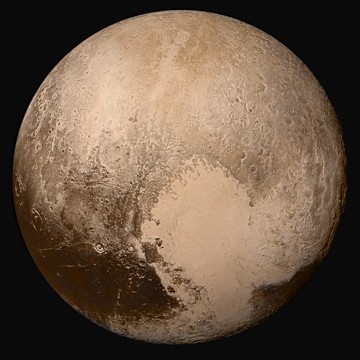Saying Hello To Pluto

By Robert Marshall, Fisher Science Education
Unless you avoided turning on the TV or computer during the summer break, more than likely you caught a glimpse of Pluto in the news. But these were not just any images. For the last time, in our lifetimes, we watched in anticipation as the New Horizons spacecraft flew by a formerly uncharted world. After a decade long endeavor, NASA has now officially visited every major celestial body in the solar system adding to the gravity of this historical event.
Following a nine year journey, covering more than three-billion miles, planet geologists have remarkable high resolution scientific data. On July 14th, New Horizons passed by just 7,800 miles above the alien surface and will continue to transmit back-to-Earth images over the next several months.
Major Discoveries From The Encounter
Pluto’s surface is stunning. One particular facial feature reveals mountain ranges, which peak 11,000 feet above the icy surface. Based on geological evidence, such ranges formed no more than 100 million years ago, suggesting near recent geological activity in this region. Most objects in the solar system with mountain landscapes are subject to gravitational forces by a larger body, such as Jovian parent planets, certainly not had by Pluto. Then, is it possible that the dwarf planet has internal heating causing plate tectonic action and therefore, will we eventually find volcanoes?
When Pluto was reclassified by the International Astronomical Union (IAU), many people around the world felt heartbroken despite all scientific reasoning. Who would have guessed Pluto would unveil its heart to mankind? Seen in the bottom right of New Horizons’ view, desert and mountain ranges come together to form this very apparent shape. Also, Pluto is mightier than previously known. Thanks to New Horizons, the mystery of Pluto’s size has been settled and the verdict might surprise you – it is larger than scientists previously thought. After these discoveries, along with poles leaking Methane and high levels of atmospheric Nitrogen, there is no telling what else we will learn about Pluto in the coming year.
Extension Questions
- What discoveries of Pluto’s largest moon, Charon, have been announced? Hydra?
- How have astronomers, robotic spacecraft engineers and geologists come together during the New Horizons mission?

